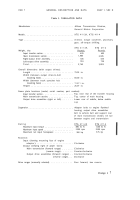TM-9-2520-234-35 - Page 45 of 323
PAR 16
DESCRIPTION AND OPERATION OF
CHAP 2, SEC II
MAIN TRANSMISSION ASSEMBLY
to clutch hub assembly 35 in such a way
that it can be locked to shaft and carrier 2
(fig. 378, fold-out 7) or locked in sta-
tionary position.
b . Output Clutch Components (fig.
377, fold-out 6).
Output clutch includes
hub 46, seven internal-splined 47, and
seven external-splined 48 plates, hub as-
sembly 35, piston assembly 40, springs 44
and retainer 43.
Hub 46 is splined to
shaft and carrier assembly 2 (fig. 378,
fold-out 7). Plates 47 (fig. 377, fold-out
6) have internal splines which engage ex-
ternal splines on hub 46. Plates 48 have
external splines which engage internal
splines in hub assembly 35. Hub 35 is
supported at one end by ball bearing 95
(fig. 375, fold-out 4) and, at the other end
by sun gear assembly 52 (fig. 377, fold-out
6), which rotates on ball bearing 50. Pis-
ton assembly 40 operates in a bore in hub
assembly 35. Springs 44, retained by re-
tainer 43, push the piston to released
position.
c . Geared Steer Clutch Components
(fig. 377, fold-out 6). The geared steer
clutch includes six disks 63, seven plates
62, piston 61 and anchor 65. The internal
splines on disks 63 engage external splines
on hub assembly 35. The external splines
on plates 62 engage internal splines on
anchor 65. Piston 61 operates in a bore of
the transmission housing (right piston
operates in a bore of the end cover) .
Anchor 65 is held stationary by bolts.
Clutch reaction plate assembly 66 serves
the steer clutch and brake jointly and is
anchored by the same bolts which retain
anchor
d.
65. -
Operation of Geared Steer
Planetary, Output Clutch and
Geared Steer Clutch (figs. 374.
377, 378, fold-outs 3, 6, 7)
(1) Planetary gearing and two
clutches operate in two ways to transmit
rotation to output shaft 18 (fig. 374, fold-
out 3). Under one condition, torque is
transmitted at a 1 to 1 ratio. Under the
other condition, there is a speed reduction
[from transfer driven gear shaft 4 (fig.
380, fold-out 9) to output shaft 18 (fig.
374, fold-out 3)] of 1.477 to 1. The right
and left systems have identical and simul-
taneous functions during straight travel of
the vehicle.
They operate separately
during steer.
(2) During straight travel in all
gears, except first and reverse 1, drive is
direct. In first gear forward and reverse
1, there is a speed reduction through the
system. This applies to the right and left
out puts simultaneously during straight
travel. During steer, drive is transmitted
to one output while the other output is
either stopped or slowed.
The vehicle
steers toward the stopped or slowed side.
(3) Two methods of steering are
employed — clutch-brake steer (first, sec-
ond and reverse 1 gears) and geared steer
(third, fourth and reverse 2 gears). In
clutch brake steer, one output drives while
the other is disengaged and braked. In
geared steer, one output is slowed by
speed reduction in the steer planetary
while the other output continues to drive
at 1 to 1 ratio. Thus, during geared steer,
the right-
and left-output clutches and
geared steer clutches operate singly. A
geared steer clutch is applied at one side
of the transmission while an output clutch
is applied at the opposite side.
(4) When hydraulic pressure is
applied to the output clutch, the piston
assembly 40 (fig. 377, fold-out 6) com-
presses plates 47 and 48 against the
reaction plate surface of sun gear assem-
bly 52. This locks sun gear 52 and shaft
and carrier assembly 2 (fig. 378, fold-out
7) together. Ring gear 14 then drives the
carrier at 1 to 1 ratio. When hydraulic
pressure is applied to the geared steer
clutch, piston 61 (fig. 377, fold-out 6)
compresses plates 62 and disks 63 against
reaction plate assembly 66. This locks sun
gear assembly 52 stationary. Ring gear 14
(fig. 378, fold-out 7) then drives shaft and
carrier assembly 2, at reduced speed,
around the stationary sun gear.
Speed
reduction (from output transfer driven
gear to transmission output coupling) is
1.477 to 1. When either clutch is released,
springs push its piston to released position.
Change 2 17
Back to Top




















